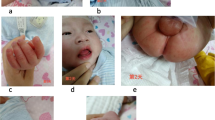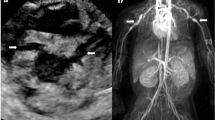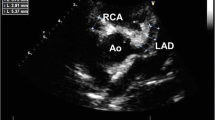Abstract
A 3-year-old girl with fever of unknown origin after a visit to Surinam was seen at our hospital. Signs and symptoms were indicative of either Kawasaki syndrome or an acute viral or (atypical) bacterial illness. No cardiac abnormalities were noted at echocardiography. She was treated with intravenous immunoglobulin and clarithromycin and made a quick recovery. Serologically, the diagnosis of murine typhus was made; a flea-borne rickettsiosis caused by Rickettsia typhi. A follow-up echocardiography 1 week later showed a dilated left coronary artery, which was normal again 4 weeks later. We suggest that this phenomenon was a manifestation of rickettsial vasculitis.

Similar content being viewed by others
References
Burns JC, Glode MP (2004) Kawasaki syndrome. Lancet 364:533–544
DiNubile MJ (1996) Reliving a nightmare: a hard (and tragic) lesson in humility. Clin Infect Dis 23:160–165
Dumler JS, Walker DH (2005) Rickettsia typhi (Murine Typhus). In: Mandell GL, Bennett JE, Dolin R (eds) Mandell, Douglas, and Bennett’s Principles and Practice of Infectious Diseases 2005. Churchill Livingstone, Philadelphia, pp 2306–2309
Dumler JS, Taylor JP, Walker DH (1991) Clinical and laboratory features of murine typhus in south Texas, 1980 through 1987. J Am Med Assoc 266:1365–1370
Edwards MS, Feigin RD (1998) Rickettsial diseases In: Feigin RD, Cherry JD (eds) Textbook of Pediatric Infectious Diseases 1998. Saunders, Philadelphia, pp 2239–2258
Heymann DL, American Public Health Association (eds) (2004) Control of Communicable Diseases Manual: An official Report of the American Public Health Association, 18th edn., American Public Health Association, Washington, DC, pp 583–590
Kafetzis DA, Maltezou HC, Constantopoulou I, et al. (2001) Lack of association between Kawasaki syndrome and infection with Rickettsia conorii, Rickettsia typhi, Coxiella burnetii or Ehrlichia phagocytophila group. Pediatr Infect Dis J 20:703–706
Nilsson K, Lindquist O, Pahlson C (1999) Association of Rickettsia helvetica with chronic perimyocarditis in sudden cardiac death. Lancet 354:1169–1173
Walker DH, Parks FM, Betz TG, Taylor JP, Muehlberger JW (1989) Histopathology and immunohistologic demonstration of the distribution of Rickettsia typhi in fatal murine typhus. Am J Clin Pathol 91:720–724
Acknowledgments
Wim van Est is gratefully acknowledged for excellent technical assistance.
Author information
Authors and Affiliations
Corresponding author
Rights and permissions
About this article
Cite this article
van Doorn, H.R., Lo-A-Njoe, S., Ottenkamp, J. et al. Widened Coronary Arteries in a Feverish Child. Pediatr Cardiol 27, 515–518 (2006). https://doi.org/10.1007/s00246-006-1324-1
Received:
Accepted:
Published:
Issue Date:
DOI: https://doi.org/10.1007/s00246-006-1324-1




